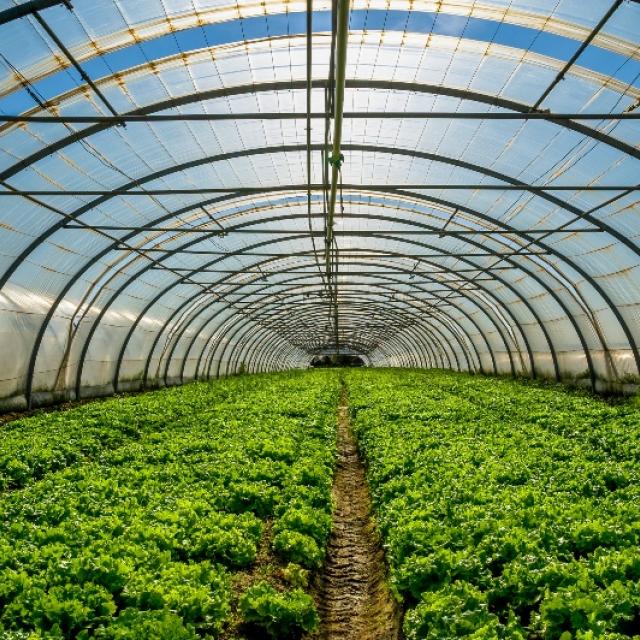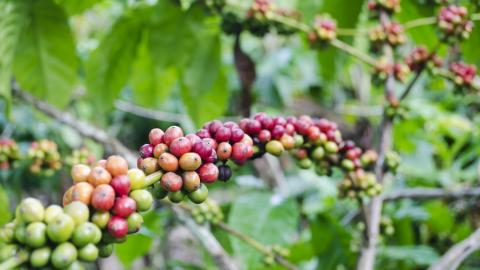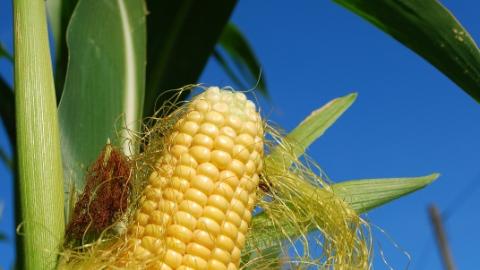It is important to satisfy the water requirements of vegetable crops in a very precise manner. Nowadays, all growers know very well that the amount of water the plant receives is a defining factor, as too much or too little can be applied. Correctly irrigated crops offer the best yields, whereas, conversely, if the plant does not receive sufficient water, the quality and quantity of the yield will be impaired.
The rooting system of the vegetable crops grown nowadays are better able to withstand dry conditions, or the alternation of dry/wet conditions, than stagnant moisture (the presence of standing water) which leads to the asphyxia of the roots. Regular doses of irrigation water are preferable to large quantities applied once or twice, which will lead to leaching, the packing-down of the soil and the risk of damaging the fruit, so it is essential to select the irrigation system that is best adapted to the crop.

The irrigation equipment
As we have just seen, irrigation has to be controlled, so an irrigation plan has to be drawn up for crops that have the same requirements. From the installation, it is important to know the amount of water discharged, so as to have an idea of the mm/hour applied and thus be able to schedule the irrigation. The installation of a programmer facilitates the irrigation management process.
Drip lines, tapes and integrated drippers
These systems are economical on water and do not contribute towards an increase in the hygrometry levels in the greenhouse. Nevertheless, these installations require a good filtration system, so as to avoid the problem of the emitters becoming clogged. Each sprinkler unit and all the drip lines should be equipped with a pressure regulator to ensure even distribution and a precise flow rate. Systematically, there should be 2 drip lines per patch (1.20 cm) for crops such as pears, peppers and cucurbits. Tomatoes and aubergines are capable of looking for the water, so one single central drip line will be sufficient. It is important to check the flow rate/m2/hour of the installations, more often than not this is estimated at 2 litres/ hour for drip irrigation. A pressure regulator should be installed at the end of the inlet manifold so as to have consistency over the whole installation.
Drip irrigation: spaced at 0.30 to 0.50 m according to the soil type, installation is difficult but it is particularly suitable for salad vegetables.
Advantages: A system that is economic on water and which can operate at low pressure. i.e. 1.1 Kg of pressure (controlled by a pressure regulator). It helps avoid the presence of plant health problems on the parts of the plant that are above ground, such as mildew, oidium, septoria (parsley, celery). With the exception of lettuce and radishes, all of the other crops adapt to drip irrigation. It is a system that is easy to handle and long-lasting, which can be used with water from the public mains system.
Disadvantages: complex installation at the beginning of the cropping season, more costly than the other options.
The 10 cm around the drippers are very wet, and this saturated area is subject to leaching, and can form an environment for pathogens. Plants should not be placed in this zone (it poses a danger for the stem). The non-irrigated zone will dry out, so fertigation will not work in this location. The wetted bulb can vary in shape and size according to the soil texture, being deeper in sandy soils. When establishing a crop with drip irrigation it is advisable firstly to plant right in front of the dripper and then after the plant takes root, drag the installation so as to move the sprinklers the width of a hand between the dripper and the plant. This kind of badly managed irrigation practice can promote the appearance of soil fungi, and root necrosis.
It is important to bear this aspect in mind because certain plants, such as Solanum, can develop a rooting system that will search for the water, but others, such as the Cucurbitaceae family (melons, squashes, etc.), are unable to do this, so these vegetables are even more in need of the drippers. With this installation, it is possible to irrigate once per day and thus the plants will not suffer in any way.
Calculating the flow rate according to the cropped area and the spacing of the drippers
There is a direct relationship between the space occupied by a crop and the irrigation = density/m2.
The flow rate for drip irrigation is around 2 litres per hour.
For example: 2 rows of tomatoes will require two drip lines at a density of 0.50 m.
Thus, on a plot of 2m x 1.50 m wide = 3 m2, the drippers will be placed at 50 cm.
We will, therefore, have: 8 drippers x 2 L/hour = 16L/H/3 m2.
= 5.3 L /H/m² = 5.3 mm of irrigation water/hour
Depending on the ETP, irrigation will be required for between 30 minutes and 1hour per day.
Flexible tapes with a hose-reel - diameter 16: an inexpensive system, spacing of 0.30 m. Some tubes have holes pierced every 20 cm. Easy installation. Problems with the risk of crushing or perforation.
Porous tubes: problem with obtaining an even distribution of the water, on account of a flow rate that is not adapted to the length or diameter of the tube.
Overhead sprinkler booms
Sprinkler booms with hanging drip or trickle systems, used in greenhouses
The sprinkler booms must be placed at 1.80 m. from the soil because, if the sprinklers are too low, there will be poor coverage around the edge of the greenhouse. The sprinklers must be installed right up to the edge of the plot so as to ensure that it is irrigated along the whole length.
|
Advantages |
Disadvantages |
|
|
|
The micro sprinkler
Advantages: inexpensive, allowing a 3 m. strip to be irrigated, for example. Installation with low flow rate irrigation (70 to 90 l / hour/ sprinkler). It allows the problems of excessive compaction to be avoided. Used with field crops, a sprinkler is installed every 2 m.
Disadvantages: a fragile system which clogs up easily and is sensitive to wind drift. The equipment has to be removed at the end of the season. The spray will not be able to get through insect nets.
The next sprinkler must be placed at the same distance as the throw radius. It is possible to irrigate an area of 3 m. wide by 100 m. in length. It is essential to ensure that the actual flow rate is linked to the pressure.
The Mankad sprinklers
There are two new Mankad micro sprinklers on the market, made of polyethylene with a throw of 20 m. in diameter, requiring a minimum pressure of 3 kg (thus applying 2 mm / hour). With higher pressures, greater levels of irrigation can be achieved. They can be placed every 10m.
Benefits: a large throw of 20 m., with a quincunx layout of 10-12 m., better distribution than the Sprinkler.
Sprinkler-type devices
An attractive option for large surface areas, these sprinklers have a throw of around 20 m.; therefore, less equipment is required. A 4.5 Kg. sprinkler placed at the beginning of the line (50 diameter nozzle) will provide a flow rate of 2 m3 per hour.
Sprinklers with a throw of 21 m. are placed every 18 m. along the line. The ideal layout would be to have a spacing of 20 m. between the lines with the sprinklers laid out in quincunx formation; and, thus, under these conditions, the precipitation rate would be 5 mm/hour. The couplings need to be renewed every 10 years.
Disadvantages: a pressure of 4.5 bar is required.
Revolving booms
Heavy investment required for small surface areas. It allows for regular irrigation, a good market garden system for permanent bed crops.
In order to be able to evaluate the quantities of water applied at the time of irrigation, these can be checked by placing a cylindrical container in the ground underneath the dripper and on the edge in the case of sprinkler irrigation. The flow rate and its variations can also be checked.
Crop requirements and installation of the irrigation system
Good irrigation management is essential, especially in greenhouses and polytunnels, to ensure that the crops are kept in good health. It is very necessary for the leaves to be dry at night.
The crops should be organised according to their requirements under specific irrigation systems and the necessary irrigation rate.
CROPS GROWN UNDER A PROTECTED ENVIRONMENT STRUCTURE
Localised irrigation with tubes or drip systems
For salad vegetables
For fruit crops and those susceptible to certain diseases
- tall crops: tomatoes, peppers, aubergines, peas, beans
- Cucurbitaceae: courgette, cucumber, melon, Chinese okra
- short crops: spinach, parsley, onion (possibly)
The density of the drippers (between 0.20 m and 0.60m) is linked to the soil texture (sand à clay) and the type of vegetable.
Sprinkler irrigation
For leaf and root vegetables :
- Lettuce, corn salad, cabbage, celery
- All no-till crops: radish, carrots, beetroot
- Certain crops such as peppers benefit from an irrigation in hot periods.
- Indifferent to the type of irrigation: Swiss chard, beetroot, spinach, parsley, onions
OPEN FIELD SYSTEMS
As it uses much less equipment, sprinkler irrigation is generally preferred.
It is necessary:
- for the emergence of no-till crops:
- for vegetables that are particularly sensitive to water deficit, such as lettuces or celeriac.
- However, when little water is available, it could be worthwhile to use a form of localised irrigation (drip irrigation or hose reel) for tall crops and the cucurbitaceae family.
Courgettes should be irrigated as little as possible during the growing season. However, they must be watered at the start (for about 3 weeks), whether the crop is sowed or planted.


